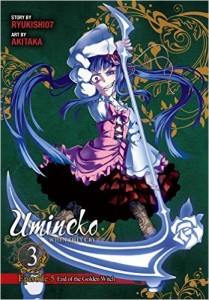Story by Ryukishi07; Art by Akitaka. Released in Japan in two separate volumes as “Umineko no Naku Koro ni: End of the Golden Witch” by Square Enix, serialized in the magazine Gangan Joker. Released in North America by Yen Press.
This review is quite late, mostly as I didn’t really want to read this volume, at all, even though I also really did. Umineko can be very difficult to read and enjoy for fun, especially if you are someone who empathizes with the pain of others. While Higurashi dealt with abuse in one of its plotlines, every single page of Umineko is about abuse on a grand scale. The daily contempt and grinding down that drives Natsuhi to the brink long before the series even begins. Erika’s joyful cruelty in removing every last shred of denial and hope in Natsuhi’s heart. And of course Bernkastel, whose loving adoption of Erika as her daughter is contrasted with the hate-filled rage seen when Erika fails, as of course she does, because there’s more of this series to go. A lot more.
As I said above, the reader is meant to empathize with Natsuhi, because the writing impels us to do so, but saying that she’s the best of the parents isn’t saying much. Besides her emotional abuse of Shannon, we find here that she is in fact a murderer herself, having been driven to it by expectations of women in the 1960s and a general sense of self-loathing pushed outwards. She gets by in life due to the poorly expressed but genuine love her husband and daughter have for her (which Erika destroys as well – note to readers, never keep a diary filled only with bad things) and a denial of reality that feels very familiar five arcs into this series. Erika destroys that as well, of course, showing us that no, Kinzo always hated her.
It’s Erika’s supposition that Natsuhi was having an affair with a deluded Kinzo that feels like one piece of sourness too many though, a further blow that is entirely unnecessary. But that’s Erika for you. There’s also Beatrice, who does finally seem to be killed off here – twice – as befits the title. She dies broken as well, as Battler still – still! – has no idea what she’s talking about with a promise that he broke, and finally begs for death. I am aware that this is the low ebb of the series, and that future arcs, while dark and depressing, have more light than this. But even for Umineko this is just hard to take.
Thankfully Battler finally comes to the rescue, a bit too late for Beatrice, but at least he gets another chance to try again. He has finally realized what Beatrice was trying to tell him, though naturally he doesn’t tell the reader that, in case there are folks who still haven’t guessed. I felt his last battle against Dlanor was a bit rushed, to be honest – it felt like they underestimated the pages needed. (This likely led to the last two arcs having EVEN MORE volumes to play around in.) And now Battler is in charge of the game board, and the next arc – Dawn of the Golden Witch – will show us how he plans to honor Beatrice’s memory.
This is a great series to read intellectually, and if you like horror and Higurashi faces (TM) it’s also excellent, but I don’t think I’ve seen a series as emotionally exhausting as Umineko in quite some time. The break between volumes is welcome.





